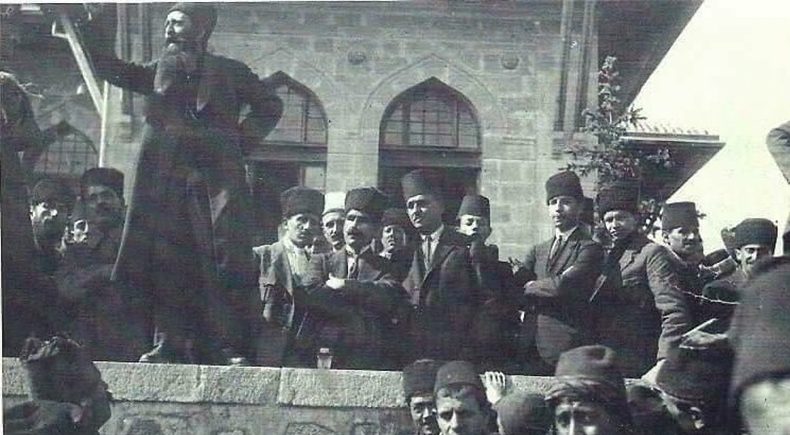The autocephalous Turkish Orthodox Patriarchate, also known as the Turkish Orthodox Church (Turk. Ortodoks Kilisesi), is a Turkish nationalist denomination whose doctrine and worship are identical to those of the Eastern Orthodox Churches.
It was founded in Kayseri in 1921 as the Autocephalous Orthodox Patriarchate of Anatolia by Pavel Karahisaritis, who supported the struggle and shared the ideals of Turkish nationalists. Karahisaritis and members of his family were not included in the population exchange that took place after Turkey’s war with Greece by decree of the Turkish government, according to Yildiz Elcin Magyar, a professor at the Department of Political Science and International Relations at Istanbul Technical University. Elzin Macar, Istanbul Greek Patriarchate, 2003).
In 1924, Karahisaritis began to serve the liturgy in Turkish, earning the support of the new Turkish Republic, founded after the overthrow of the Ottoman Empire. He declared the Ecumenical Patriarchate of Constantinople to be ethnically centric and in favor of the Greek population. After his excommunication, Karahisaritis, who later changed his name to Zeki Erenerol, convened a Turkish ecclesiastical council, which elected him Patriarch in 1924. He moved to Istanbul, where he found some followers in Galata, a neighborhood with a large Greek population. However, most Turkish citizens who professed Orthodoxy retained their affiliation with the Ecumenical Patriarchate. Father Eftim was a village priest from the Turkish-speaking Karamanli Greek community in Cappadocia, Anatolia. Eftim and his sons call themselves patriarchs. First, his older son Turgut, then his younger brother, and now Pasha Erenerol (the brother of the arrested Sevgi), called by the United States, is the fourth Turkish Orthodox patriarch. On September 1, 1965, Sevgi and Pasha’s father, Seljuk Erenerol, occupied the Greek minority churches of Aya Nikola and Aya Yani, which were included in the foundation of his patriarchate. Ep. Meliton says that he visited the temples and in the church of Aya (St.) Nicholas he saw laundry in the yard, because there is no longer a liturgical life in it. Aya Yani is leased to the Assyrian community, and “St. Our Lady of Katafiani ”, where the headquarters of the so-called“ Turkish Patriarchate ”is located, was recently connected with the coup plotters from the Ergenekon affair. In 2008, Sevgi Erenerol, daughter of Papa Eftim III and sister of today’s primate, Papa Eftim IV, who was also a spokesman for the Patriarchate, was arrested for links to the Turkish illegal nationalist organization Ergenekon. The investigation established that the Patriarchate was the headquarters of this conspiratorial organization. Sevgi Erenerol has been an active nationalist for years, and under Alparslan Turkes, she ran for the Milliyetzi Hareket Partisi [Nationalist Movement Party] in the parliamentary elections. Following the revelations of the investigation into the connections between the leadership of the Turkish Patriarchate and the secret coup organization Ergenekon,
At the numerous requests of the Ecumenical Patriarchate for the return of the seized churches, the Turkish government returned the Church of Christ in 1947, but for the needs of changes in the road infrastructure, it was expropriated and demolished, and the monetary compensation for the expropriation was paid to the Turkish Orthodox Church. patriarchy. When Turgut Erenerol died, his brother, Seljuk, requested a meeting with representatives of the Eastern Orthodox Patriarchate in Constantinople. On Sept. 10. In 1992, three bishops received him in Fener. Erenerol states that it is ready to return the three churches to the Gala of the Ecumenical Patriarchate, provided that the Patriarchate recognizes the name “Turkish Orthodox Church” and Erenerol’s right to administer it. He withdrew the anathema of his father, Eftim, and gave him the right to manage the revenues from the 72 properties that belonged to these three church waqfs (foundations). Bishop Meliton of the Ecumenical Patriarchate in Fener, in a deliberate interview with Today’s Zaman (YONCA POYRAZ DOĞAN, İSTANBUL, 07 February 2008, Thursday), presented the claims of the Patriarchate of Constantinople on the churches formerly occupied by the Erenerol family. In 1924, they occupied the Panagia Katafiani temple in Galata, beating Greek priests. Later, in 1926, they occupied another Christ Church, for which the Greeks had proper ownership documents.
Patriarchs:
Papa Eftim I (1923-1962) – born Pavlos Karahisaritis, later changed his name to Zeki Erenerol;
Papa Eftim II (1962-1991) – b. George Karahisaritis, later changed his name to Turgut Erenerol; eldest son of Papa Eftim I;
Papa Eftim III (1991-2002) – b. Seljuk Erenerol, younger son of Pope Eftim I;
Papa Eftim IV (2002 -) – b. Pasha
About 20 churches were organized in the Turkish Orthodox Church in America in 1966, under the leadership of Archbishop Jivet Christoph, an African-American physician named Christopher M. Kragh. In 1969, this church community had 14 temples and 6 missionary parishes. The Turkish Orthodox Church in the United States continued to exist in the 1970s, but in the early 1980s, Archbishop Krag moved to Chicago and opened a health clinic, continuing to maintain the “trademark,” the American Orthodox Church, the Diocese of Chicago and North America.












